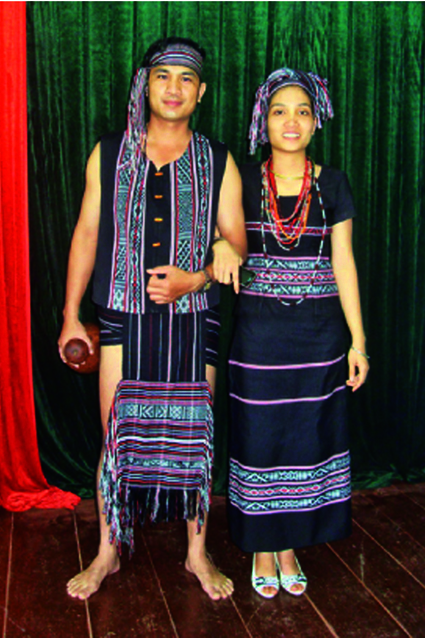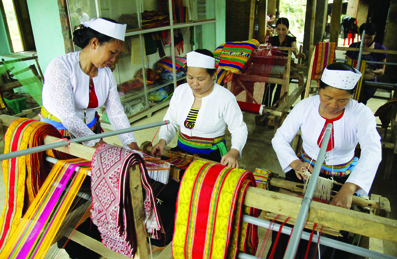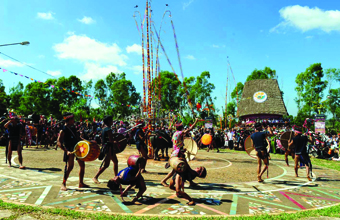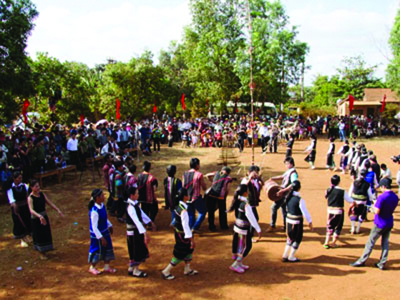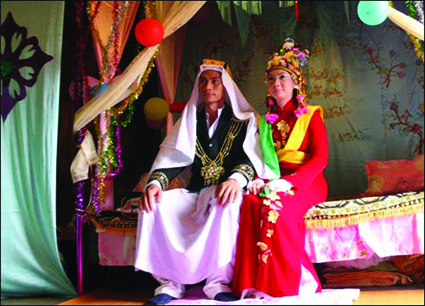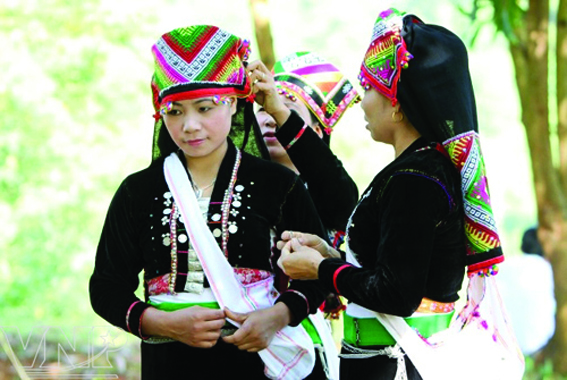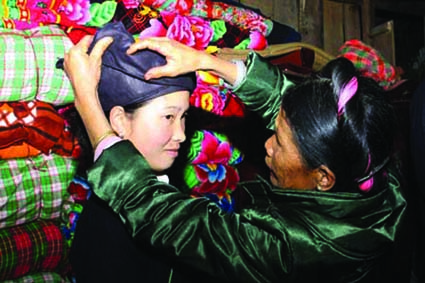>>"Van Kieu" - Its customs, practices and conventions
Ta Thi Tam
Ethnology Institute
The Bru-Van Kieu, a Mon-Khmer language group, live mostly in mountainous areas of the central provinces of Quang Tri, Quang Binh and Thua Thien Hue with a population of around 74,500.
The Bru-Van Kieu originally lived in the central part of Laos and migrated to Vietnam amid historical changes, inhabiting the western part of Quang Tri province. The group settled in the area of Van Kieu mountain and later was named after this mountain.
 |
Newly refurbished traditional stilt houses of the Bru-Van Kieu in Dakrong district, Quang Tri province __Photo: Ho Cau/VNA |
The Bru-Van Kieu live mainly on farming, growing rice and other crops in both flat and mountainous areas. Except in western Quang Tri where soil is fertile and farming techniques are relatively developed, the Bru-Van Kieu mostly use simple farming tools such as machete, axe, rake and hole-pricking sticks.
Bru-Van Kieu people choose land for farming or village building based on omens they see in dreams. To select his farming land, a Bru-Van Kieu man clears a land plot, usually in an old-growth forest, and mark it. That night, if he sees in his dream persons with disabilities or many people carrying children in their arms, it is believed a bad omen and he has to select another land plot. The same rule applies when Bru-Van Kieu people select land to build their village or home.
The Bru-Van Kieu usually clear land for farming from the second to the fourth lunar months, sow seeds in the fifth month and harvest in the ninth or tenth month. They are also good at gardening, hunting and fishing. As the Bru-Van Kieu mostly barter goods with other groups, trade rarely develops in their living areas.
A Bru-Van Kieu village is often located separately on a hill or mountain area near a river or stream. Houses are often built along the river or stream but are sometimes around the communal house. They must be arranged in a certain circle so that their ridge beams must not point to one another.
When building a house, the prop dedicated to the family spirits must be erected first. This prop will never be changed so it must be made of good log. To celebrate a new home, the family hangs a lantern on each prop. The clan head is the first person to enter the new home, carrying a container of water with aloe wood. After praying in front of the ancestor altar, he pours the water onto the prop dedicated to the family spirits. He then lights a fire in the stove which must be kept alive for three nights in a row in the belief that the family will enjoy prosperity. At twilight of the first night, the clan head burns a small bamboo tree and beats it onto the house props to create explosive sounds as a way to get rid of evil spirits. Before moving in the new home, the wife of the family owner spreads out a mat in their room while the oldest son does the same thing in the guest room.
A Bru-Van Kieu stilt-house usually has two roofs made of rattan or palm leaves. The length of a house depends on the number of family members and their financial conditions. A rich family has a longer and broader home as compared with a poor one. No matter how long and big it is, a house only has two entrance doors: one for men, including guests, and the other for women. At the two gables are wooden objects in the shape of buffalo horns or birds which are not only for decoration but also for keeping the thatch on the roof.
The first part in a Bru-Van Kieu home from the left is for receiving guests. Next is the part accommodating the prop dedicated to the family spirits. Then come rooms for old people, the parents and children. The final part is where to keep home utensils. Each room has an entry without a door, and separating wattles. The family has one stove for cooking and another in the guest room for warming in winter.
Annually, before the harvest time, every family repairs its home or rebuilds its lean-to to keep rice paddies.
The Bru-Van Kieu wear their hair in a bun, men and women alike. A single woman wears a bun on the left while a married one ties her hair in a bun on top of her head. Women also wear white headdresses. The Bru-Van Kieu do not know how to weave. In the past, they used the bark of forest trees for making loincloths. Women wear loincloths longer than men’s.
A Bru-Van Kieu family is patriarchal in which the oldest man is the owner. When this man dies, his power and property are passed to his oldest son. Daughters are not entitled to inheritance.
The Bru-Van Kieu follows monogamy under which a woman stays with her husband’s family. From the age of 15 or 16, boys and girls do not sleep at home but at the communal house - the place of courting for young couples. When a couple fall in love and agree to get married, the boy is supposed to give his girlfriend some silver coins or betel and areca every time they meet. The lovers each find a matchmaker to inform their parents of their affair. The girl’s parents will invite her maternal uncle to discuss their daughter’s marriage. After getting the two families’ consent, the groom must give the bride wedding offerings, including money and clothing while his family must prepare betrothal presents for the bridal family. The groom’s family will take the bride home on a date chosen by the bride’s family. The groom’s party taking the bride home is not supposed to enter the house of the bride who will wait downstairs to receive betrothal presents. The presents include a copper cooking pot, silver bars, a beaded necklace and an indispensable item - a sword. The sword must be handed to the bridal family with its hilt pointing to the recipient; otherwise, the marriage will be cancelled. After the bride leaves for her husband’s home, some young men from the bridal family will run after the groom’s procession as if they seek for the girl before joining them to accompany the bride.
Arriving her husband’s home, the bride is supposed to go through several rituals, including washing her feet, having meals with her husband and lighting a fire. Those accompanying the bride stay at the groom’s home that night and the next morning return to her family together with the groom’s family, carrying with them four bowls which symbolize the bridal family’s acceptance of its new son-in-law. The bride’s family conducts a ceremony in which the sword is stuck into the stove and some water is poured onto it. The family then kills a pig for offerings to its ancestors and makes a feast to treat the groom’s. After finishing the feast, another ritual called doi cua (asking for presents) starts when the parents, maternal uncle and brothers of the bride ask the groom to give them whatever they want. The groom’s family are supposed to give all the presents claimed by the bridal family, a tough obligation for any Bru-Van Kieu groom which can take him years to fulfill.-
